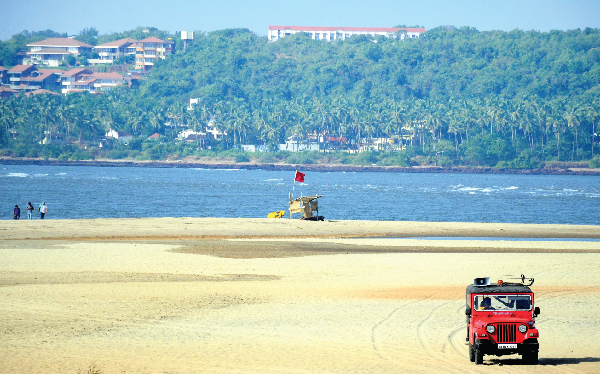
Karan Sehgal
In the last few years, heavy monsoon rains in June and July had also brought along hordes of tourists to Goa, who were only too keen to get a respite from heat-wave in rest of the country.
Unfortunately, this year, the trend has been exactly opposite. Tourists shunned Goa in the months of June and July this time even as it rained a lot more than two previous years. Tourism stakeholders attributed this trend to a number of factors.
Ralph de Sousa, Chairman, de Souza Group, said, “The number of tourists has clearly come down this monsoon in Goa compared to previous monsoon. Earlier, we used to get bulk of MICE (meetings, incentives, conferences and exhibitions) business, where agents would bring large groups of tourists to the state for events in significant number. This monsoon even MICE business has significantly reduced. I think this is because of GST.”
MICE segment typically includes events, as a lot of corporates situated in metros would come to Goa with groups of employees for parties, off-site and etc. It was this segment, which was really badly affected because GST was applicable on declared tariff of a hotel and not on actual tariff until recently.
Suppose a hotel declared a tariff of Rs 8,000 per room per night (28% GST is applicable on Rs 7,500 and above tariff). But, it managed to sell its rooms for only Rs 6,000 (18% GST is applicable on less than Rs 7,500 tariff). It still had to pay 28% tax because it had declared a tariff higher than Rs 7,500.
Just a few days ago, GST Council decided that tax would now be levied on actual tariff and not on declared tariff, which has brought huge relief to tourism industry of the state.
de Sousa continued, “Now that GST will be charged on actual tariff and not on declared tariff, we expect some relief. I think the market for MICE will pick up from August.”
It was not only MICE business, which got the hammering this monsoon as number of free-individual travellers (FITs) has also come down.
Nikheel Shirodkar, General Manager, Ibis Styles in Calangute, said, “In my opinion, overall market of tourists from online travel agents (OTAs) came down this monsoon. Earlier, our hotel used to get a lot of tourists from OTAs. But, we have seen a huge growth in MICE segment at our property this time. We have a lot of meeting space, which is really useful when it comes to attracting MICE segment.”
Shirdokar continued, “When you get tourists from MICE segment, they not only occupy your rooms but they even give you food & beverages (F&B) business. This is because groups tend to have lunch and dinner at the property itself. But, individual travellers typically go to restaurants outside the hotel for lunch and dinner.”
Ibis Styles is clearly an exception because it still managed to grow its MICE business when most other hotels are struggling. Most hotels saw a huge drop in both MICE business and individual travellers segment, which resulted in reduction in their occupancy rates.
Unfortunately, for hotels, there was not a single long weekend in either June or July. A long weekend typically attracts tourists in large numbers especially from cities like Mumbai and Delhi, as people choose to come to Goa to get a break from their hectic schedules. Lack of long weekend did make matters worse for tourism trade.
Bhushan Bordekar, General Manager, Windsor Bay in Calangute, said, “This monsoon has not been good for us at all. At two properties, we had an average occupancy of just 20-30% in July. In last year’s monsoon, we had clocked 80% average occupancy. Even as the number of tourists came down this monsoon, the number of hotel rooms in Baga to Sinquerim belt has grown rapidly. People are offering really low rates but even then tourists are not coming.”
The number of hotels have increased at an alarming pace in the state. Consider the belt of Candolim to Sinquerim, where a lot of new properties sprang up in the last 2-3 years. In simple words, the supply (number of hotel rooms) has increased but the demand (number of tourists) has not increased in monsoon season.
Polly D’Cruz, General Manager, The Golden Crown Hotel & Spa in Colva, said, “The months of June and July have turned out to be really difficult for us. There are tourists, but very few. We even floated offers but nothing came up. We had only 30% occupancy in July at our property. In August, we are expecting 70%-80% occupancy because few agents are sending groups back to back.”
D’ Cruz continued, “OYO is also affecting market because it offers heavy discounts to tourists. Due to this, tourists start expecting discounts from everyone. We are a 4-star property. If we give discounts, the quality of tourists at my property suffers.”
Clearly, the going has not been easy for tourism industry in the current monsoon but few properties fared relatively better.
Siddharth Savkur, General Manager, Alila Diwa Goa, said, “Although we had stable business, but we have seen that monsoon wasn’t as robust this year as it was in the earlier two years. Newer destinations like Sri Lanka are doing really well, as a lot of tourists are choosing to go there. 28% GST on luxury hotels also made us expensive.”
After struggling for two straight months of June and July, hoteliers are now expecting August to be a lot better. Only time will tell whether the next few months will revive the fortunes of the tourism industry or not.